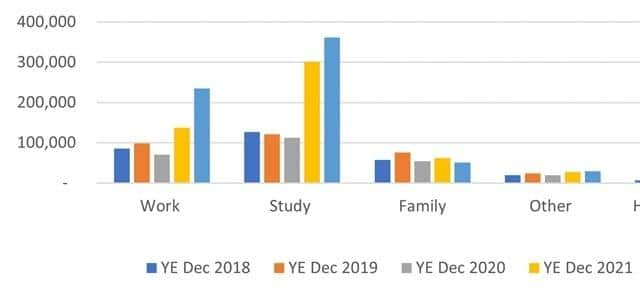Migrant crisis: Where are Britain’s immigrants coming from and why?
The proportion of people moving to the UK from countries outside the European Union has doubled from 40 per cent to 80 per cent of immigration over the past four years, a report has revealed.
Based on the latest estimates, nearly 1.2 million people immigrated to Britain last year, while around 557,000 left the country, resulting in a net migration figure of 606,000, think-tank Cebr said.
Advertisement
Hide AdAdvertisement
Hide AdThe number of immigrants from outside the EU nearly tripled over the period, rising from 327,000 in 2018 to 925,000 last year. EU immigration, on the other hand, has slowed dramatically, falling from 52 per cent of total immigration in 2018, to just 13 per cent in 2022. The UK officially left the EU in January 2021.


The rise was driven by an increase in immigrants arriving via humanitarian routes. That group accounted for 19 per cent of all non-EU immigrants last year, fuelled by the arrival of tens of thousands of people fleeing the war in Ukraine and arrivals from Hong Kong under a new route opened for those with British national status living in the region, which is now controlled by China.
Meanwhile, the number of students from non-EU countries taking degree courses at British universities rose by 184 per cent.
The report said: “These figures likely reflect broader structural changes in the make-up of the population of immigrants coming to the UK as well as specific one-off factors. The 2022 figures are still influenced by a bounce-back effect following the restrictions on the movement of people during the pandemic years. This likely explains some of the uptick in the number of non-EU immigrants coming for study reasons, which is up by 184 per cent in 2022 compared to 2018.
"Immigrants arriving via humanitarian routes accounted for 19 per cent of all non-EU immigrants in 2022, up from just 2 per cent in 2018. This can largely be explained by Ukrainians fleeing war and British Nationals Overseas from Hong Kong coming to the UK.


The think-tank added: "Away from these one-off factors, a crucial observation is that non-EU immigrants with worker visas have risen sharply from 86,000 in 2018 to 235,000 in 2022, hinting at more persistent changes in the make-up of immigrants arriving to the UK. This will likely persist even as the number of arrivals via other channels falls back."
It emerged earlier this year that Scottish businesses were having to look further afield to recruit workers as a combination of Brexit and Ukraine invasion caused a staffing crisis.
The report also pointed to changes in the economic situation of non-EU workers in recent years and said regular assessments of the profiles of migrants coming to the UK were necessary for accurate economic forecasts.
Advertisement
Hide AdAdvertisement
Hide Ad“For years, evidence showed that EU immigrants are on average more highly skilled than non-EU immigrants and were therefore expected to deliver a larger fiscal benefit to the UK,” the report said. “However, more recent analysis by the Migration Observatory shows that foreign-born workers from North America & Oceania, India and the EU-14 are the most likely to be employed in high-skilled jobs, while those from recent EU accession countries, South Asia and Latin America were least likely to be found in such jobs."
Comments
Want to join the conversation? Please or to comment on this article.
